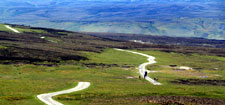Recreation and Tourism
The rural landscapes of County Durham are attractive to both residents and visitors. Tourism is important to the economy, and particularly in rural areas like the North Pennines, and there is considerable demand for recreational and sporting activities in the countryside around towns and villages. Environmentally sustainable tourism and recreation can encourage appreciation of the landscape, wildlife, culture and history of the countryside while providing new opportunities for diversification and employment.
New recreational or tourist development and associated activities can also bring changes to the rural landscape in a number of ways.
- Development may have an ‘urbanising’ effect on the rural landscape through the introduction of new buildings and land uses.
- The tranquillity of the countryside may be affected by noisy activities, increased traffic levels and lighting.
- Mature landscapes and landscape features may be damaged or lost.
- Land may be managed without the expertise or resources of farmers and foresters.
- The conversion of traditional buildings and the scale or design of new buildings may be out of keeping with the vernacular character of the locality.
- Pressures of visitor numbers can lead to damage to footpaths and fragile habitats.
- Recreational developments may bring opportunities to re-use and maintain traditional buildings, or to support traditional forms of land management.
Tourism and recreational activities play an increasingly important role in the rural economy. It is essential that they do not detract from the very qualities that make the countryside attractive to visitors and residents.
Issues and Objectives
Planning for New Development in the Countryside
Most new development requires planning permission and District Wide Local Plans contain policies for recreational development in the countryside, as will the Local Development Frameworks that are to replace them. The Landscape Assessment and Strategy will contribute to the preparation or review of development plans, informing policy making, and will assist in evaluating proposals that come forward.
Objectives
- To inform Local Development Framework policies.
Guiding New Development
The impacts of new development are heavily influenced by the details of site selection and design. The County Durham Landscape Character Assessment provides baseline information on landscape character which can be used to inform these processes. Building-in Sustainability, the regional guide to sustainable building and development, provides guidance on how to adopt sustainability principles in building works. Further detailed guidance is needed on design principles and issues in different landscapes. A number of Supplementary Planning Documents (SPD) are being proposed as part of Local Development Frameworks to give further guidance on design issues.
Objectives
- To inform and support the development of a Supplementary Planning Documents dealing with design issues.
Urbanisation
Changes from agriculture or forestry to recreation based land uses can erode the specifically rural character of the countryside, introducing features more characteristic of urban or suburban landscapes. This ranges from the development of new roads and buildings to the creation of formal or exotic landscaping such as that found on golf courses. The extent to which this happens depends partly on the location of new development and partly on the way it is designed and managed.
Objectives
- To minimise urbanising effects on the rural landscape by ensuring that new development respects the character of the local landscape and contributes to the landscape strategy for the area.
- To encourage the use of species and materials native to, or characteristic of, the local landscape in landscaping proposals.
Tranquillity
New development can erode the tranquillity of the countryside. Noisy activities like motor sports can be particularly intrusive as can the high levels of lighting required for activities like golf driving ranges. Increased numbers of visitors can lead to higher levels of traffic on rural roads, which makes them less attractive to other users. Noise from traffic can disturb the tranquillity of the wider landscape.
Objectives
- To encourage the selection of suitable locations for noisy activities and particularly areas close to existing noise sources like busy roads.
- To minimise the effects of lighting by encouraging the selection of suitable locations for developments like driving ranges and by promoting good practice in lighting design.
- To encourage sustainable transport solutions in planning for new recreational development.
Conservation of Landscape Features
Development or changes in land use can result in the loss of mature landscape features and habitats either directly, by their removal, or indirectly through changes in management. Some forms of development, like golf courses or fishing lakes, may involve changes to the landform affecting either natural topography or historic features like rigg and furrow. Retaining existing features can bring maturity, quality and a sense of identity to new development. Opportunities may also arise to restore or create features and habitats that are declining in the wider landscape.
Objectives
- To encourage the protection and conservation of existing landscape features in new development.
- To encourage the restoration or creation of locally distinctive landscape features and habitats.
Equestrian Activities
Features associated with horse riding – stables and buildings, ranch fencing and horse jumps – can bring a domestic scale and suburban character to working agricultural landscapes.
Pony paddocks are sometimes poorly managed; hedgerows may be browsed or unmanaged and the ground may be heavily poached or weed infested. There is a general lack of guidance and advice for small-scale land managers who often lack the expertise of traditional land managers.
Objectives
- To encourage good management of land used for equestrian activities.
Buildings
The reuse of older buildings can be an important way of retaining them as features of the landscape. Their conversion to new uses can often be done in a way that respects their character. New buildings can be out of scale or character with their surroundings unless located and designed with care. In some cases specialised uses may preclude the use of traditional designs or materials in buildings, and robust screening in the form of woodland planting may be required if they are to be assimilated into the surrounding countryside.
Objectives
- To encourage the re-use or sensitive conversion of existing buildings in the countryside.
- To ensure that new buildings respect the scale and architectural character of the locality or are adequately screened by vegetation.



